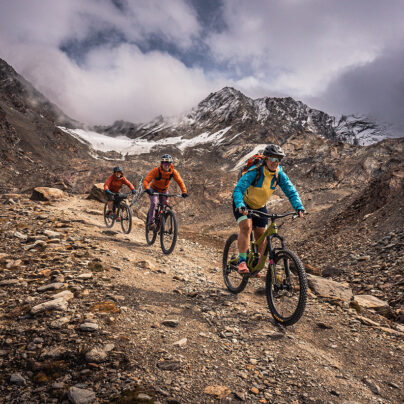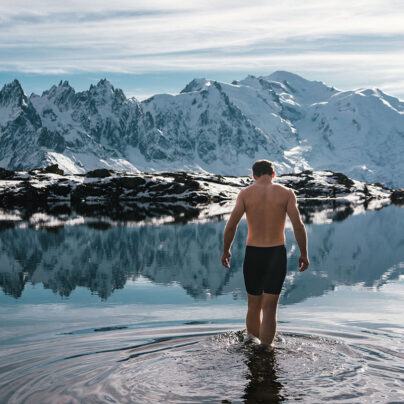Fjäll Finding
A Solo Packrafting Journey in the Swedish Fjälls
Rachel Murray
Seeking the self-reliance of a solo packrafting journey into the Swedish fjälls, Rachel Murray treads the fine line between safety and adventure.
The sound of rushing whitewater crescendos quickly. As I paddle around the bend, the calm river transforms into a playground of multiple channels, chutes, and drops. I take out at the bank to scout a possible line from the safety of the shore. Everything looks runnable, but not without the safety backup of other paddlers. Alone and far from civilisation, I am acutely aware of every risk factor – and in this context even the most minor river feature seems threatening. I settle on paddling the first entry rapid and portaging the rest. If things go awry, there will still be time to self-rescue (though I’ll need to be prompt) before the real drops begin.
I relaunch my packraft back onto the water, secure my thigh braces, and take a last look at my line before peeling out into the flow. Waves lash my face and soak my drysuit. Confidently, I charge through the rapid before eddying out at the first moment possible, then get off the water to hike my fully loaded packraft downstream, bypassing a few more serious rapids. With the river gradient expected to considerably increase again up ahead, I get back in my boat and paddle just a few hundred more metres to complete the first packraft section of my journey.
Half an hour later, back on land and changing into hiking gear, it hits me. What am I doing out here alone? Is this safe? A light mist from the river sprays across my face. I watch the water tumble through a series of rapids, then disappear over a roaring 15m drop just meters from where I had taken out. I had been so composed all morning, so confident in my decision-making. But suddenly, I begin to feel uneasy.
What if I had missed my takeout eddy just before the waterfall? I knew in advance that the river would drop off; should I have eddied out earlier? Was my line through the small boulder garden too risky?
I don’t even want to think about what could have happened. I finish packing away my wet gear and set off on foot towards the cloud-shrouded mountains, quietly relieved to say goodbye to the river behind me.



I started my 11-day adventure three days ago from Abisko – a small settlement in the far north of Sweden – after catching an 18-hour night train all the way up from Stockholm. Abisko is typically known as the start or end point of the famous Kungsleden trail, but I’ve chosen a different route, stitching together lesser-known tracks, some river travel, and a few off-route sections and summits.
Having paddled my first river section today, I’ll now traverse over to the next river valley and cache my packraft before embarking on a five-day hiking loop. I’ll then circle back to the river, pick up my boat, and paddle the last two days out of the fjälls and back into civilisation.
It’s my first time going solo for such an extended period. It’s also my first multi-day packrafting trip. I’ve hiked alone before, but only for a few days at a time, and I’ve kayaked plenty, but only in groups. This time, there’s only me to make the calls.
As I begin my hike away from the river, my nervous energy dissipates, and I settle into a slow but constant rhythm. Startled reindeer watch me nervously from below as I climb higher into the fjälls, reminding me that this is Sápmi land – home to the indigenous reindeer-herding Sámi people – and that this land is only wild to those who do not live here. The afternoon passes slowly, following the twists and turns of a pumping glacial-melt stream up a smaller side valley. The seasonal melt coupled with the last few days’ rain has filled the stream’s banks to the brim. For now, I’m content with watching the water go by, without the pressure of having to paddle it.
Finally, I leave the last patches of vegetation behind and emerge into a new alpine landscape: rocks and boulders strewn everywhere, colourless, raw, and devoid of life. In the distance, I can just make out the mouth of a small glacier, once large enough to carve out this vast, open landscape. I regret not having stopped lower down in the valley to camp. With the temperature dropping, I layer on warm clothes, pitch my tent, and wait for the night to pass.



The following day, the clouds seem only to have thickened. As I set off, the steep pass ahead, which I need to ascend, is entirely cloaked in white; I can barely make out my morning’s objective. I climb quickly, small cairns guiding me the fastest way possible up through the mist. Droplets condense on the messy whiskers of hair hanging loose around my forehead. I reach the highest point in 20m visibility, but the cairns are nowhere to be seen.
I check my compass and orient myself due south. I know that visibility will return as soon as I drop below the cloud base, but I can’t help but feel on edge. I stretch out both hiking poles and prepare myself for yet another downward lunge, my 28kg packraft-laden backpack testing my stability – both physical and emotional, it seems. A first tear escapes down my cheek. What am I feeling right now? Apprehension? Loneliness? I’m not even really sure. I shuffle my way along through the misty boulder fields, trying to recall what I’m doing out here again.
Startled reindeer watch me nervously from below as I climb higher into the fjälls, reminding me that this is Sápmi land –home to the indigenous reindeer-herding Sámi people–and that this land is only wild to those who do not live here.
Over the last few years, it has been easy for me to tag along on other friends’ trips, shying away from risk-management, navigation, and decision-making responsibilities. Of course, trips with friends are always fun – and maybe safer – but something was itching inside of me: what would a trip look like if I were fully responsible for its design and realisation? Where would I go? What decisions would I make? And how would I feel out there, hearing the roaring rush of whitewater and deciding whether to run a rapid? Or when the mountaintops were cast pink and only I was there to experience it? After years of waiting for the right time, place, and people, I just didn’t want to wait any longer.
So, I booked my train ticket and, for the first time in my life, found myself frantically obsessing over the weight of every piece of gear I planned to take. I thought about plans B and C in case the river was too high, or in the worst-case scenario that I would swim and lose all my packraft gear. I trained my self-rescue, studied rivers using satellite imagery, and cut corners off my freeze-dried meal bags to save space and weight. I teetered between hubris and self-doubt, excitement and nervousness. The anticipation and preparation were almost as mentally consuming as the trip itself.



Over the course of the next 11 days, I would become all too familiar with boulder-hopping in slippery, snowy conditions, paddling in bitterly cold winds and camping under a seemingly impenetrable blanket of stratus clouds. I would deal with blisters, a broken tent-door zip, and an invisible slow puncture in my mattress that would keep me cold and awake at night. But I would also experience the wondrous joys of travelling solo.
I would learn to trust my experience, skill, and judgement when it came to route-planning and risk management. I would come to appreciate the quietness and freedom of my own company, to harness the power of positive self-talk to fend off crippling self-doubt. And, of course, my respect and awe for the vastness and beauty of this harsh subarctic landscape would only grow.
On the sixth day, I would be rewarded with a few hours of clear skies – enough time to make it up one of Sweden’s lesser-known 2,000m summits. On the ninth day, the weather would stabilise, and I would replan my route to camp high in the snow at a mountain lake, squeezing in one last summit climb before descending back to the valley and packrafting out of the fjälls in full sunshine.
***
Peering out from my tent, I have been transported. The fierce winds of the previous days’ storm are gone; only the rustling of my sleeping bag disturbs this new-found quiet. I lace on my boots and crawl outside to be greeted by my own reflection rippling in the lake next to my tarp. Around me, the mountains, which were invisible yesterday, now cradle my campsite, standing guard should the storm return. Their white flanks rise high into the cloud. I scale the bank behind me – all rocks and soft, new snow – and observe my surroundings from above. On the other side of the lake, yesterday’s tracks descend from the pass; to the south, a hanging glacier drops deep into the valley below.
All at once, the sun bursts over the ridgeline. I watch the tallest peaks catch the light first, the shadow line quickly receding down the mountain face as the sun continues to climb. The last lingering clouds burn away and sunlight pours into the basin. I feel myself unwind. My shoulders loosen, my fists uncurl – it’s easier to stay present with the warmth of the sun reminding me where I am. I give myself a few moments to reset and prepare myself mentally for the last few days still to come. Finally, I make my way back to my tent, ready to begin the next chapter.
Read Rachel Murray’s Single Moment, ‘Recalibrate’, in Sidetracked magazine Volume 23, available to order now.
Follow Rachel on Instagram via @rachelmurray.nz





